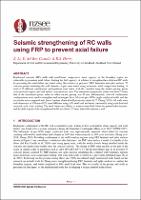| dc.contributor.author | Li, Zhibin | |
| dc.contributor.author | del Rey Castillo, Enrique | |
| dc.contributor.author | Henry, Rick | |
| dc.date.accessioned | 2023-08-28T04:23:33Z | |
| dc.date.available | 2023-08-28T04:23:33Z | |
| dc.date.issued | 2023-04-19 | |
| dc.identifier.uri | https://repo.nzsee.org.nz/xmlui/handle/nzsee/2607 | |
| dc.description.abstract | Reinforced concrete (RC) walls with insufficient compressive strain capacity at the boundary region are vulnerable to premature axial failure, limiting the drift capacity. A solution to strengthen these deficient RC walls was tested by preventing the axial failure using fiber reinforced polymer (FRP) laminates and spike anchors. Monotonic axial compression testing was firstly conducted on 75 concrete prisms simulating the wall boundary region. A total of 22 different confinement configurations were tested, with the variables being the anchor spacing, prism cross-sectional aspect ratio and anchor cross-sectional area. The improvement of the measured failure strain reached up to about 400% when anchor spacing was 90 mm. Subsequently, some of the tested confinement configurations were selected to strengthen and test three full-scale pre-1970s singly reinforced walls with dimension of 150 mm×1920 mm×3840 mm subjected to reversed cyclic static loading and 10% axial load. The test results were used to compare with the as-built wall previously tested by T. Zhang (2019). The axial failure was changed into tension-controlled failure by gradual rebar fracture on all the tested walls, and the drift at peak of the strengthened walls was improved by up to about 167%. | |
| dc.language.iso | en | |
| dc.publisher | New Zealand Society for Earthquake Engineering | |
| dc.relation.ispartofseries | 2023;112 | |
| dc.subject | Risk mitigation by retrofitting | |
| dc.title | Seismic strengthening of RC walls using FRP to prevent axial failure | |
| dc.type | Article | |

